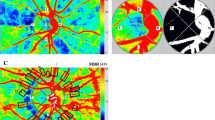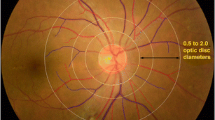Abstract
Introduction
Diabetic retinopathy is characterized by morphological lesions in the ocular fundus related to impairment of the retinal blood flow. The morphological lesions display a dynamic pattern of new formation and resorption of lesions, with a turn-over within days to weeks that may reflect basic pathophysiological mechanisms underlying the disease. However, a possible relationship between short-term fluctuations in diabetic retinopathy and risk factors for the long-term prognosis of diabetic retinopathy, such as the arterial blood pressure, has not been investigated.
Methods
Five patients with moderate non-proliferative diabetic retinopathy were examined by fundus photography and measurement of the blood pressure at 1- to 2-week intervals for up to 1 year. The numbers of microaneurysms/haemorrhages and hard exudates in the macular area were counted, and changes in these counts were related to changes in the arterial blood pressure.
Results
The five patients discontinued the study after 1–12 months, which resulted in between 5 and 39 examinations per patient, and amounted to a total of 101 examinations. There was a significant covariation between microaneurysms/haemorrhages and hard exudates, whereas there was no significant covariation between the number of either type of lesion and the blood pressure.
Conclusions
The cause of dynamic changes in diabetic retinopathy lesions occurring over days to weeks may involve other factors than changes in the arterial blood pressure.


Similar content being viewed by others
References
Diabetes Control and Complications Trial (DCCT) (1995) The effect of intensive diabetes treatment on the progression of diabetic retinopathy in insulin-dependent diabetes mellitus. Arch Ophthalmol 113: 36–51
UK Prospective Diabetes Study Group (UKPDS 38) (1998) Tight blood pressure control and risk of macrovascular and microvascular complications in type 2 diabetes. Br Med J 317:703–713
Agardh CD, Agardh E, Torffvit O (1997) The association between retinopathy, nephropathy, cardiovascular disease and long-term metabolic control in type 1 diabetes mellitus: a 5 year follow-up study of 442 adult patients in routine care. Diabetes Res Clin Pract 35:113–121
Gallego PH, Craig ME, Hing S, Donaghue KC (2008) Role of blood pressure in development of early retinopathy in adolescents with type 1 diabetes. A prospective cohort study. BMJ 337:a918
Riva CE, Sinclair SH, Grunwald JE (1981) Auto regulation of retinal circulation in response to decrease of perfusion pressure. Investig Ophthalmol Vis Sci 1(1):34–38
Kohner EM, Patel V, Rassam SM (1995) Role of blood flow and impaired autoregulation in the pathogenesis of diabetic retinopathy. Diabetes 44(6):603–607
Blum M, Pils C, Müller UA, Strobel J (2006) The myogenic response of retinal arterioles in diabetic retinopathy. Ophthalmologe 103(3):209–213
Frederiksen CA, Jeppesen P, Knudsen ST, Poulsen PL, Mogensen CE, Bek T (2006) The blood pressure-induced diameter response of retinal arterioles decreases with increasing diabetic maculopathy. Graefes Arch Clin Exp Ophthalmol 244(10):1255–1261
Bek T, Hajari J, Jeppesen P (2008) Interaction between flicker-induced vasodilatation and pressure autoregulation in early retinopathy of type 2 diabetes. Graefes Arch Clin Exp Ophthalmol 246(5):763–769
Bek T (1999) Diabetic maculopathy caused by disturbances in retinal vasomotion. A new hypothesis. Acta Ophthalmol Scand 77(4):376–380
Bek T, Helgesen A (2001) The regional distribution of diabetic retinopathy lesions may reflect risk factors for progression of the disease. Acta Ophthalmol Scand 79:501–505
Taylor E, Dobree JH (1970) Proliferative diabetic retinopathy. Site and size of initial lesion. Br J Ophthalmol 54:11–18
Chaturvedi N, Sjølie AK, Stephenson JM, Abrahamian H, Keipes M, Castellarin A, Rogulja-Pepeonik Z, Fuller JH (1998) Effect of lisinopril on progression of retinopathy in normotensive people with type 1 diabetes. The EUCLID study group. EURODIAB controlled trial of lisinopril in insulin-dependent diabetes mellitus. Lancet 351:28–31
Knudsen ST, Bek T, Poulsen PL, Hove MN, Rehling M, Mogensen CE (2003) Effect of losartan on diabetic maculopathy in type 2 diabetic patients: a randomized, double-masked study. J Int Med 254:147–158
Adler AI, Stratton IM, Neil HA, Yudkin JS, Matthews DR, Cull CA, Wright AD, Turner RC, Holman RR (2000) Association of systolic blood pressure with macrovascular and microvascular complications of type 2 diabetes (UKPDS 36): a prospective observational study. BMJ 321:412–419
Stratton IM, Kohner EM, Aldington SJ, Turner RC, Holman RR, Manley SE, Matthews DR (2001) UKPDS50: risk factors for incidence and progression of retinopathy in type II diabetes over 6 years from diagnosis. Diabetologia 44:156–163
Mehlsen J, Erlandsen M, Poulsen PL, Bek T (2009) Identification of independent risk factors for the development of diabetic retinopathy requiring treatment. Acta Ophthalmol Scand, Nov 12 [Epub ahead of print]
Stefánsson E (2006) Ocular oxygenation and the treatment of diabetic retinopathy. Surv Ophthalmol 51(4):364–380
Hove MN, Kristensen JK, Lauritzen T, Bek T (2006) The relationship between risk factors and the distribution of retinopathy lesions in type 2 diabetes. Acta Ophthalmol Scand 84:619–623
Acknowledgments
The study was supported by the VELUX Foundation. The skilful assistance of nurse photographer Helle Hedegaard is gratefully acknowledged.
Author information
Authors and Affiliations
Corresponding author
Additional information
Financial relationships
None.
The author has full control of all primary data, and agrees that Graefe's Archives for Clinical and Experimental Ophthalmology can review the data if requested.
Rights and permissions
About this article
Cite this article
Bek, T. Lack of correlation between short-term dynamics of diabetic retinopathy lesions and the arterial blood pressure. Graefes Arch Clin Exp Ophthalmol 249, 267–271 (2011). https://doi.org/10.1007/s00417-010-1525-4
Received:
Revised:
Accepted:
Published:
Issue Date:
DOI: https://doi.org/10.1007/s00417-010-1525-4




